改进的Hegselmann-Krause舆论演化模型
- 格式:pdf
- 大小:2.43 MB
- 文档页数:8
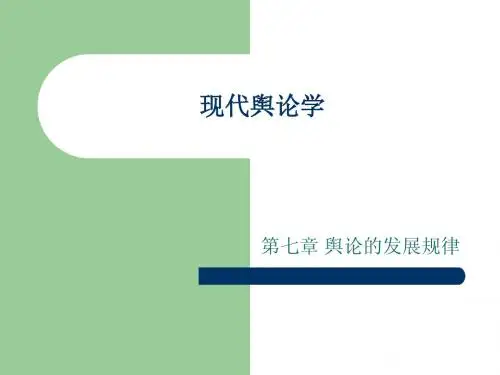
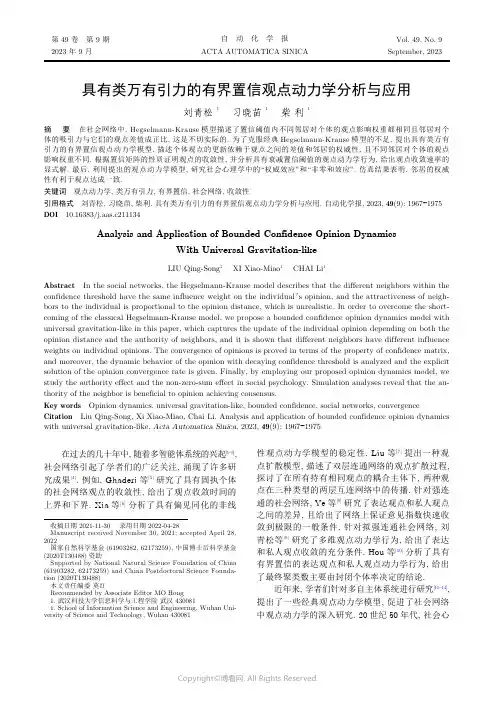
具有类万有引力的有界置信观点动力学分析与应用刘青松 1习晓苗 1柴 利1摘 要 在社会网络中, Hegselmann-Krause 模型描述了置信阈值内不同邻居对个体的观点影响权重都相同且邻居对个体的吸引力与它们的观点差值成正比, 这是不切实际的. 为了克服经典Hegselmann-Krause 模型的不足, 提出具有类万有引力的有界置信观点动力学模型, 描述个体观点的更新依赖于观点之间的差值和邻居的权威性, 且不同邻居对个体的观点影响权重不同. 根据置信矩阵的性质证明观点的收敛性, 并分析具有衰减置信阈值的观点动力学行为, 给出观点收敛速率的显式解. 最后, 利用提出的观点动力学模型, 研究社会心理学中的“权威效应”和“非零和效应”. 仿真结果表明, 邻居的权威性有利于观点达成一致.关键词 观点动力学, 类万有引力, 有界置信, 社会网络, 收敛性引用格式 刘青松, 习晓苗, 柴利. 具有类万有引力的有界置信观点动力学分析与应用. 自动化学报, 2023, 49(9): 1967−1975DOI 10.16383/j.aas.c211134Analysis and Application of Bounded Confidence Opinion DynamicsWith Universal Gravitation-likeLIU Qing-Song 1 XI Xiao-Miao 1 CHAI Li 1Abstract In the social networks, the Hegselmann-Krause model describes that the different neighbors within the confidence threshold have the same influence weight on the individual 's opinion, and the attractiveness of neigh-bors to the individual is proportional to the opinion distance, which is unrealistic. In order to overcome the short-coming of the classical Hegselmann-Krause model, we propose a bounded confidence opinion dynamics model with universal gravitation-like in this paper, which captures the update of the individual opinion depending on both the opinion distance and the authority of neighbors, and it is shown that different neighbors have different influence weights on individual opinions. The convergence of opinions is proved in terms of the property of confidence matrix,and moreover, the dynamic behavior of the opinion with decaying confidence threshold is analyzed and the explicit solution of the opinion convergence rate is given. Finally, by employing our proposed opinion dynamics model, we study the authority effect and the non-zero-sum effect in social psychology. Simulation analyses reveal that the au-thority of the neighbor is beneficial to opinion achieving consensus.Key words Opinion dynamics, universal gravitation-like, bounded confidence, social networks, convergenceCitation Liu Qing-Song, Xi Xiao-Miao, Chai Li. Analysis and application of bounded confidence opinion dynamics with universal gravitation-like. Acta Automatica Sinica , 2023, 49(9): 1967−1975在过去的几十年中, 随着多智能体系统的兴起[1−3],社会网络引起了学者们的广泛关注, 涌现了许多研究成果[4]. 例如, Ghaderi 等[5]研究了具有固执个体的社会网络观点的收敛性, 给出了观点收敛时间的上界和下界. Xia 等[6]分析了具有偏见同化的非线性观点动力学模型的稳定性. Liu 等[7]提出一种观点扩散模型, 描述了双层连通网络的观点扩散过程,探讨了在所有持有相同观点的耦合主体下, 两种观点在三种类型的两层互连网络中的传播. 针对强连通的社会网络, Ye 等[8]研究了表达观点和私人观点之间的差异, 且给出了网络上保证意见指数快速收敛到极限的一般条件. 针对拟强连通社会网络, 刘青松等[9]研究了多维观点动力学行为, 给出了表达和私人观点收敛的充分条件. Hou 等[10]分析了具有有界置信的表达观点和私人观点动力学行为, 给出了最终聚类数主要由封闭个体率决定的结论.近年来, 学者们针对多自主体系统进行研究[11−14],提出了一些经典观点动力学模型, 促进了社会网络中观点动力学的深入研究. 20世纪50年代, 社会心收稿日期 2021-11-30 录用日期 2022-04-28Manuscript received November 30, 2021; accepted April 28,2022国家自然科学基金(61903282, 62173259), 中国博士后科学基金(2020T130488)资助Supported by National Natural Science Foundation of China (61903282, 62173259) and China Postdoctoral Science Founda-tion (2020T130488)本文责任编委 莫红Recommended by Associate Editor MO Hong 1. 武汉科技大学信息科学与工程学院 武汉 4300811. School of Information Science and Engineering, Wuhan Uni-versity of Science and Technology, Wuhan 430081第 49 卷 第 9 期自 动 化 学 报Vol. 49, No. 92023 年 9 月ACTA AUTOMATICA SINICASeptember, 2023理学家French[15]提出基于个体的观点形成模型. 1974年, DeGroot[16]提出基于个体加权平均的观点动力学模型, 即后来的DeGroot模型. 通过针对每个个体引入偏差, 将DeGroot模型推广到非线性观点动力学模型[6]. 另一方面, 通过引入个体对自身初始观点的固执, 文献[17]提出Friedkin-Johnsen 模型. 之后, Parsegov等[18]将Friedkin-Johnsen模型推广到了多维观点动力学模型. Tian等[19]研究了问题序列上的Friedkin-Johnsen观点动力学模型,给出了问题序列上观点达到一致的充要条件. 在考虑每次观点更新过程中, 随机选取一对个体进行观点交流, Deffuant等[20]提出Deffuant-Weisbuch模型. 随后, 通过两种不同的方法推广了Deffuant-Weisbuch模型[21], 验证了观点几乎必然达到一致.最近, Dong等[22]研究了基于领导概念的观点动态共识构建过程, Mei等[23]提出基于评价网络的学习过程模型.上述观点动力学模型是线性模型, 经典的Heg-selmann-Krause模型[24]是非线性模型, 描述了每个个体只与其置信阈值内的邻居进行观点交互. 与Def-fuant-Weisbuch模型[20]相比, Hegselmann-Krause 模型每次进行观点交流的个体的数量更多, 因而交流效率更高, 观点能够更快地收敛或者达成一致.在实际应用方面, Hegselmann-Krause观点动力学模型可应用于机器人平面、空间交会问题[25]和社会心理学中“权威效应”[26]等方面的研究. 故研究Heg-selmann-Krause或有界置信观点动力学模型, 具有重要应用价值和意义.近年来, 国内外学者针对有界置信模型进行了较为深入的研究[27], 例如Canuto等[28]通过欧拉方法, 研究了基于有界置信模型的动态系统的一致性问题. 通过考虑噪声环境, Su等[29]提出了具有噪声的有界置信模型, 展示了随机噪声如何显著地影响同步的观点, 给出了观点达成拟一致的充分条件.基于改进的有界置信模型, 针对初始观点分布, Yang 等[30]给出了观点收敛到一个聚类的充分条件. 通过正规化交流权重的凸性和Gronwall-Halanay型不等式, Haskovec[31]研究了具有时滞的有界置信模型的渐近一致性问题. 基于离散异构的有界置信模型, Vasca等[32]提出了一种基于非影响相似度区间的个体置信阈值自适应策略, 分析了有限时间的观点动力学行为.鉴于上述对有界置信观点动力学模型国内外研究现状的分析, 目前主要存在以下三个问题: 1)在改进的观点动力学模型中, 邻居对个体的影响力与其观点差异值成正比, 与实际情景存在一定的差距[28];2) 现有文献主要是采用仿真方法研究改进的有界置信模型, 缺乏较为完整的理论研究框架[27]; 3)现有的有界置信模型研究中, 较少研究观点动力学模型的应用[32], 例如考虑建立的观点动力学模型在社会心理学中的应用. 此外, 根据社会心理学中的认知理论可知[33], 由于不同个体社会背景和认知能力不一样, 不同邻居对个体产生的影响就会不一样[33];个体与邻居的观点差异值越大, 邻居对其影响应该越小[34].为了克服上述问题, 本文提出具有类万有引力的有界置信模型, 并分析了观点的演化问题. 本文的主要贡献如下:1)提出了新的具有类万有引力的有界置信观点动力学模型. 解决了Canuto等[28]模型中个体的影响力与其观点差异值成正比这一不符合实际情景的社会现象, 并考虑了个体的权威性;2)在理论上给出了观点收敛的充分条件且分析了基于衰减置信阈值的观点动力学模型, 完善了Chen等[27]的理论研究内容;3)应用本文提出的具有类万有引力的有界置信观点动力学模型, 研究了社会心理学中的“权威效应”和“非零和效应”[35], 填补了Vasca等[32]缺乏的应用研究;4)得到了邻居的权威性和正态分布的初始观点都有利于观点达成一致, 这一重要结论.1 问题描述首先, 回顾经典的有界置信观点动力学模型[24]:i∈V={1,2,···,n}x i(k)iN i=N(i,x(k))={j∈V||xj(k)−xi(k)|≤ε} i|N i|iε式中, , 表示个体的观点值.表示个体所有邻居的集合, 表示个体的邻居数目, 其中为置信度阈值.i1/|N i|ixj(k)−xi(k)j i|xj(k)−xi(k)|通过模型(1)可知, 个体的邻居对其影响权重全部相同即其权重都为. 事实上, 不同个体具有不同的认知水平和不一样的教育背景, 个体受影响程度或被其他个体影响的程度是不同的. 另一方面, 个体的观点值更新依赖于, 即邻居对个体的吸引力与观点差异值成正比. 实际上, 个体与邻居的观点差异值越大, 其对个体的影响越小. 为此, 本文提出一个具有类万有引力的有界置信观点动力学模型:1968自 动 化 学 报49 卷∑w ij (k )式中, 社会影响权重 为:w ij (k )由于社会影响权重 中:是受万有引力表达式的启发[27], 故称观点动力学模型(2)为具有类万有引力的有界置信观点动力学模型.tanh (·)众所周知, 万有引力的大小与物体的质量以及两个物体之间的距离有关. 物体的质量越大, 它们之间的万有引力就越大; 物体之间的距离越远, 它们之间的万有引力越小. 根据社会心理学中的认知理论可知[33], 个体权威性或者社会话语权越大, 其影响力(权重)越大; 个体与邻居的观点差异值越大, 邻居对其影响应该越小[34]. 根据上述关系, 将万有引力与影响力对应, 物体的质量与个体权威性对应, 物体之间的距离与观点差异值对应. 另一方面,类似于经典的Hegselmann-Krause 模型, 保证权重在[0, 1]之间, 故引入 函数给予保证. 综上所述, 便可得到权重式(4). 此外, 在本文的第4节中, 应用所提出的观点动力学模型研究社会心理学中的“权威效应”和“非零和效应”. 从应用结果可进一步地说明权重式(4)的合理性.d ij j i |N j |i j d ij =1d ij (k )j N (j,x (k ))i j x j (k )−x i (k )j i i 事实上, 描述了个体 与个体 观点值越接近, 彼此间的影响也就越大. 此外, 描述了个体 的邻居 的权威性或者社会话语权[27]. 从而本文提出的模型也很好地描述了, 在一个社会中, 拥有大量人脉资源的人享有更多的话语权, 对他人的社会影响也就更大. 注意到, 如果 , 则具有类万有引力的有界置信观点动力学模型(2)退化成经典Hegselmann-Krause 模型(1). 事实上, 是一个关于个体 邻居的个数 和个体 与个体 观点值之差 的函数. 易知个体 的邻居数越多, 与个体 的观点值相差越小, 则其对个体 的差异影响权重越大, 其函数关系见图1.j i w ij (k )(x j (k )−x i (k ))根据本文提出的具有类万有引力的有界置信观点动力学模型(2)可知, 个体 对个体 的影响由 所决定, 其函数关系见图2.x j (k )−x i (k )j N (j,x (k ))i j N (j,x (k ))j i x j (k )−x i (k )i j 由图2可知, 当 一定时, 个体 的邻居数 越多, 其对个体 的影响越大. 当个体 的邻居数 一定时, 个体 与个体 的观点值之差 越大, 个体 的观点值受到个体 的影响先增大后减小. 因此, 要想某个体能对指定个体施加更大的影响, 需要折中进行考虑.0.20−0.2002040601−1w i j (k )(x j (k ) − x i (k ))|N j |x j (k) − x i (k )j i 图 2 个体 对个体 观点的影响j iFig. 2 The influence of individual on theopinion of individual本文主要研究具有类万有引力的有界置信模型(2)的观点演化问题, 给出了观点收敛的充分条件,并将所提出的观点动力学模型应用到社会心理学中的“权威效应”和“非零和效应”.2 收敛性分析本节将分析具有类万有引力的有界置信观点动力学模型(2)的收敛性.i ∈V x i (0)x ∗i ∈R 定义 1. 在观点动力学模型(2)中, 对任意个体 的初始观点值 , 如果存在 , 使得:α∈R 则称模型(2)收敛. 特别地, 如果存在定常数 ,使得:1.00.5001−1d i j (k )|N j |x j (k) − x i (k )204060d ij (k )|N j |x j (k )−x i (k )图 1 关于 和 的函数图d ij (k )|N j |x j (k )−x i (k )Fig. 1 The trajectories of with respect to and 9 期刘青松等: 具有类万有引力的有界置信观点动力学分析与应用1969则称观点达成一致.x i (0)∈[0,1],i ∈V 定理 1. 对于任意观点初值 ,观点动力学模型(2)收敛.证明. 模型(2)可重写为:模型(5)可进一步写为:A (k,x (k ))a ij (k )式中, 置信矩阵 的元素为:A (k,x (k ))θ≥00≤tanh (θ)≤1∑j ∈N i \{i }w ij (k)∈(0,1)易知社会影响矩阵 是行随机矩阵.注意到, 对任意的 , 易得 . 则由式(3)可知, . 故:A (k,x (k ))即 的对角线元素大于0.j i j /∈N i w ij (k )=0i /∈N j w ji (k )=0a ij (k )=0a ji (k )=0,∀i,j ∈V A (k,x (k ))δ>0A (k,x (k ))δ另一方面, 当个体 与个体 的观点值之差大于置信阈值时即 , 则 . 类似地, ,则 . 因此, 当且仅当 . 此外, 易知 中一直存在正元素,即存在 , 使得 的最小正元素大于 .A (k,x (k ))综上所述, 矩阵 满足文献[36]给出模型收敛的充分条件, 从而模型(6)收敛. 故观点动力学模型(2)收敛. □根据定理1, 可得下列推论.x i (0)∈[0,1],i ∈V k τA (k,x (k ))=(1/n )1n 1T n ,k ≥k τ1n =[1,1,···,1]T 推论 1. 对于任意观点初值 ,如果观点动力学模型(6)在经过 次演化后观点达成一致, 则置信矩阵 ,其中 .k τ|x i (k )−x j (k )|→0,∀i,j ∈V,k ≥k τN i =N j =n,证明. 如果观点经过次演化后达成一致, 即 且 则:由式(3)可得:()a ij =1/n,k ≥k τ进一步地, 根据式(7)可知, . □为了得到进一步的结果, 令:x i (0)∈[0,1],i ∈V ε=1推论 2. 考虑观点动力学模型(2), 对于任意观点初值 . 如果置信阈值 且:则ε=1|N i |=n 证明. 由于置信阈值 , 则所有个体均可交流, 即 . 由观点动力学模型(2)可知:j i w ij (k )(x j (k )−x i (k ))i j w ji (k )(x i (k )−x j (k ))w ij (k )=w ji (k )注意到, 邻居 对个体的影响为 ,类似地, 邻居 对个体 的影响为 , 然而, . 易得:则式(9)可退化为:即x (k )=x (0)故 . □第2节主要考虑的是置信阈值不变的情况. 事实上, 观点动力学模型可看作一个谈判的过程模型.一方面, 个体期望它的邻居在每一轮谈判中显著地向它的观点靠拢, 以便继续谈判, 衰减置信阈值可描述这一情景[37]; 另一方面, 具有衰减置信阈值的观点动力学模型可应用于研究图中的社区检测[37]和社会心理学中的“非零和效应”. 故第3节将分析基于衰减置信阈值的观点动力学模型. 此外, 本文将利用建立的具有衰减置信阈值的Hegselmann-Krause 观点动力学模型研究社会心理学中的“非零1970自 动 化 学 报49 卷和效应” (见第4.2节).3 衰减的置信阈值为了描述个体在谈判的过程中, 个体期望它的邻居在每一轮谈判中显著地向它的观点靠拢, 以便继续谈判. 本节考虑下列具有衰减置信阈值的观点动力学模型:式中:和R >00<ρ≤1式中, 和 .x i (0)∈[0,1],i ∈V x i (k ),i ∈Vx i ∗i k ∈V 定理 2. 考虑观点动力学模型(10), 对于任意观点初值 , 观点 是收敛的. 进一步地, 令 表示个体 的最终观点值,对于所有的 , 则:证明. 根据式(10), 有:由式(12), 可得:w ij (k )∈(0,1/|N ρi |]j ∈N ρw ij (k )≤1注意到, , 则, 故:∀k,τ=0,1,···令 , 则由式(14)可知:因此:ρ∈(0,1)x i (k )k =0,1,···τ→∞式中, . 易知序列 , 是一个Cauchy 序列, 故其收敛. 通过令式(15)中的, 则可得式(13). □ε=1类似于观点动力学模型(2), 如果置信度阈值 且式(11)退化为式(8). 则观点动力学模型(10)具有和推论2一样的结论.4 观点动力学模型的应用4.1 权威效应本节将利用本文提出的具有类万有引力的有界置信观点动力学模型(2), 研究普遍存在的社会心理学现象: 权威效应. 所谓权威效应是指一个人要是地位高、有威信、受人敬重, 那他所说的话及所做的事就容易引起别人重视, 并让他们相信其正确性.权威效应的普遍存在, 一方面是由于人们总认为权威人物往往是正确的楷模, 服从他们会使自己具备安全感, 增加不会出错的保险系数; 另一方面, 由于人们总认为权威人物的要求往往和社会规范相一致, 按照权威人物的要求去做, 会得到各方面的赞许和奖励. 在现实生活中, 有很多利用权威效应的例子, 比如做广告时请权威人物赞誉某种产品, 在辩论说理时引用权威人物的话作为论据等. 在人际交往中, 利用权威效应, 能够引导或改变对方的观点和行为.考虑由10个个体组成的社会网络, 设初始观点值为:ε=0.2|N 4|=8置信阈值 . 根据初始观点值和置信阈值可得初始时刻个体之间的网络结构, 如图3所示(图中自环未画出). 易知个体4具有8个邻居即, 具有最大的权威性或者话语权.w ij 0.510.21w ij 0.460.24当观点动力学模型(2)中 为式(8)时, 即不考虑邻居的权威性, 其观点演化曲线如图4(a)所示, 其中形成两簇的最终观点值分别为 和 .当观点动力学模型(2)中 为式(3)时, 即考虑邻居的权威性, 其观点演化曲线如图4(b)所示, 其中形成两簇的最终观点值分别为 和 . 出现这一现象是由于受到了权威者个体4的影响 (图4中虚线为个体4的观点曲线), 两簇观点都向个体4的观点值靠近.为了说明初始条件的客观性, 可随机选取一个9 期刘青松等: 具有类万有引力的有界置信观点动力学分析与应用1971x (0)=[0.25,0.25,0.32,0.45,0.5,0.7,0.7,0.7,0.7,0.8]T ,|N 5|=7个体为权威个体, 不失一般性地, 选取个体5为权威个体, 个体初始观点值可设为 其网络拓扑图如图5所示. 易知, 个体5具有7个邻居即 .类似地, 其观点演化曲线如图6所示, 可以看出, 由于受到权威个体5的影响 (图6中虚线为个体5的观点曲线), 两簇观点都向个体5的观点值靠近.4.2 非零和效应本节将利用本文建立的具有衰减置信阈值的观点动力学模型(10), 研究社会心理学中“非零和效应”.“非零和效应”是一种合作下的博弈, 博弈中做一定的让步, 双方的收益或损失的总和不是零, 观点达成一致, 谈判便可成功[35]. 另一方面, 衰减置信阈值可描述个体期望它的邻居在每一轮谈判中显著地向它的观点靠拢, 以便继续谈判.R =0.8ρ=0.7x i (0)∈[0,1],i ∈V x (0)∈[0,1]n 为了利用本文提出的模型(10)研究社会心理学中“非零和效应”, 令 , , 当个体观点初值 均匀分布时, 观点动力学模型(10)的仿真结果如图7(a)所示, 观点达到了一致, 说明谈判取得成功, 实现了“非零和效应”.当个体观点初值 正态分布时, 其结果如图7(b)所示, 观点达到一致性的速度比个体观点初值均匀分布情况快, 说明谈判过程中, 当持中立观点的人较多时, 谈判取得成功的时间更少.1020102000.51.000.51.0xk /s k /s x(a)(b)图 7 非零和效应Fig. 7 Sum non-zero effect5 仿真分析5.1 基于固定置信阈值的模型仿真分析n =50ε=0.3x i (0)∈[0,1],i ∈V 本节将通过仿真分析本文所得到的理论结果.设群体总个体数 , 置信度阈值 , 观点初值 均匀分布. 将改进的Heg-12345678910图 3 网络拓扑结构 (个体4为权威个体)Fig. 3 Network structure (individual 4 is theauthoritative individual)0.20.40.60.8xk /s (a)(b)k /s 00.20.40.60.8图 4 权威效应 (个体4为权威个体)Fig. 4 Authority effect (individual 4 is theauthoritative individual)12345678910图 5 网络拓扑结构 (个体5为权威个体)Fig. 5 Network structure (individual 5 is theauthoritative individual)0.20.40.60.8x k /s k /s x0.20.40.60.8(a)(b)图 6 权威效应 (个体5为权威个体)Fig. 6 Authority effect (individual 5 is theauthoritative individual)1972自 动 化 学 报49 卷selmann-Krause 观点动力学模型[32]与本文提出的观点动力学模型(2)进行对比, 其观点演化曲线分别如图8(a)和图8(b)所示, 可以看出, 在改进的Hegselmann-Krause 模型[32]中, 观点形成拟一致.有趣的是在具有类万有引力的有界置信模型(2)中, 观点则出现两极分化. 这是因为在文献[32]改进的Hegselmann-Krause 模型中, 观点相似的个体不再进行交互, 而本文提出的具有类万有引力的有界置信模型(2)中, 考虑了影响权重的互异性.02040600.51.000.51.0xk /s020改进的模型模型 (2)|N j | = 14060204060204060k /s x00.51.00246xk /s k /s h (k)(a)(b)(d)(c)图 8 初值为均匀分布时的观点演化Fig. 8 Opinion evolution when the initial value isuniformly distributed|N j |=1当在具有类万有引力的有界置信模型(2)中不考虑个体权威性时即 , 其观点演化曲线如图8(c)所示, 观点仍然达到两极分化, 但其观点形成两极分化的速度比图8(b)的慢, 说明权威个体有利观点的演化速度.为了描述观点演化过程中所有观点的相对变化, 定义变量:η(k )=0其曲线如图8(d)所示. 可以看出, 在文献[32]改进的Hegselmann-Krause 模型中, 观点相对变化较大,而在具有类万有引力的有界置信模型(2)中, 观点相对变化较小; 另一方面, 在不考虑权威个体的模型(2)中, 观点相对变化最小, 但观点收敛速度最慢. 特别地, 如果 , 则群体观点收敛.在现实生活中, 针对一些(如不感兴趣的)话题, 大多数人的观点比较趋于中立, 而只有少部分x i (0)∈[0,1],i ∈V 人的观点比较极端. 为此, 设个体观点初值 为正态分布. 将改进的Hegselmann-Krause 模型与本文建立的有界置信模型(2)进行比较, 其观点曲线如图9(a)和图9(b)所示. 可以看出, 基于有界置信模型(2)的观点达到一致, 而基于改进的Hegselmann-Krause 模型的观点不收敛, 这是因为改进的Hegselmann-Krause 模型中, 观点相似的个体不再进行交互.20406000.51.000.51.020改进的模型模型 (2)|N j | = 140602040602040600.51.0024(a)(b)(d)(c)xxxh (k )k /s k /s k /s k /s图 9 初值为正态分布时的观点演化Fig. 9 Opinion evolution when the initial value isnormally distributed|N j |=1η(k )当具有类万有引力的有界置信模型(2)不考虑个体权威性时即 , 其观点曲线如图9(c)所示, 可以看出, 基于观点动力学模型(2)的观点达到一致速度较慢. 根据 的定义和图9(d)可知, 基于改进的Hegselmann-Krause 模型的观点相对变化最大.5.2 基于衰减置信阈值的模型仿真分析R =0.3ρ=0.7n =50x i (0)∈[0,1],i ∈V x (0)∈[0,1]n 本节将对具有衰减置信阈值的观点动力学模型(10)进行仿真分析. 设 , 和 ,当观点初值 均匀分布时, 观点动力学模型(10)形成了3个均匀的观点簇, 仿真结果如图10(a)所示. 当观点初值 正态分布时, 其结果如图10(b)所示, 形成了4个观点簇. 总之, 基于衰减置信阈值的模型(10)的观点都是收敛的.N c N m n x (0)R ρ设 表示群体最终观点簇数, 表示群体最大观点簇中的个体数量. 在个体数 和观点初值 以及阈值参数 都固定的情况下, 随着 的增9 期刘青松等: 具有类万有引力的有界置信观点动力学分析与应用1973N c N m ρN c =1大, 群体最终观点簇数量 减少, 如图10(c)所示.由图10(d)可知, 群体最大观点簇中个体数量 随着 的增大而增大. 特别地, 当 时, 则群体观点达到一致性.6 结束语本文提出具有类万有引力的有界置信观点动力学模型, 描述了不同邻居对个体的观点影响权重不一样, 且个体观点的更新与观点之间的差值和邻居的权威性有关. 根据置信矩阵的性质证明了观点的收敛性, 在不考虑邻居权威性的条件下, 给出了最终观点平均值的显式表达式. 在衰减置信阈值的条件下, 得到了观点收敛速率的显式解. 利用本文提出的观点动力学模型, 研究了社会心理学中的“权威效应”和“非零和效应”. 仿真分析表明, 邻居的权威性和正态分布的初始观点都有利于观点达成一致.ReferencesZhou B, Lin Z. Consensus of high-order multi-agent systems with large input and communication delays. Automatica , 2014,50: 452−4641Chen Shi-Ming, Shao Sai, Jiang Gen-Lan. Distributed event-triggered fixed-time scaled consensus control for second-order multi-agent systems. Acta Automatica Sinica , 2022, 48(1):261−270(陈世明, 邵赛, 姜根兰. 基于事件触发二阶多智能体系统的固定时间比例一致性. 自动化学报, 2022, 48(1): 261−270)2Zhou B. Consensus of delayed multi-agent systems by reduced-order observer-based truncated predictor feedback protocols.IET Control Theory & Applications , 2014, 8(16): 1741−17513Wang Long, Tian Ye, Du Jin-Ming. Opinion dynamics in social4networks. Scientia Sinica: Informationis , 2018, 48(1): 3−23(王龙, 田野, 杜金铭. 社会网络上的观念动力学. 中国科学: 信息科学, 2018, 48(1): 3−23)Ghaderi J, Srikant R. Opinion dynamics in social networks with stubborn agents: Equilibrium and convergence rate. Automatica ,2014, 50(12): 3209−32155Xia W, Ye M, Liu J, Cao M, Sun X M. Analysis of a nonlinear opinion dynamics model with biased assimilation. Automatica ,2020, 120: Article No. 1091136Liu C, Wu X, Niu R, Aziz-Alaoui M A, Lü J. Opinion diffusion in two-layer interconnected networks. IEEE Transactions on Circuits and Systems I: Regular Papers , 2021, 68(9): 3772−37837Ye M, Qin Y, Govaert A, Anderson B D, Cao M. An influence network model to study discrepancies in expressed and private opinions. Automatica , 2019, 107: 371−3818Liu Qing-Song, Li Ming-Peng, Chai Li. Analysis and applica-tion of multidimensional opinion dynamics on social networkswith oblivion individuals. Acta Automatica Sinica , DOI:10.16383/j.aas.c210091(刘青松, 李明鹏, 柴利. 具有遗忘群体的社会网络多维观点动力学分析与应用. 自动化学报, DOI: 10.16383/j.aas.c210091)9Hou J, Li W, Jiang M. Opinion dynamics in modified expressed and private model with bounded confidence. Physica A: Statist-ical Mechanics and Its Applications , 2021, 574: Article No.12596810Zheng Wei, Zhang Zhi-Ming, Liu He-Xin, Zhang Ming-Quan,Sun Fu-Chun. Dynamic feedback mean square consensus con-trol based on linear transformation for leader-follower multi-agent systems. Acta Automatica Sinica , 2022, 48(10): 2474−2485(郑维, 张志明, 刘和鑫, 张明泉, 孙富春. 基于线性变换的领导-跟随多智能体系统动态反馈均方一致性控制. 自动化学报, 2022,48(10): 2474−2485)11Yi J W, Chai L, Zhang J. Average consensus by graph filtering:New approach, explicit convergence rate, and optimal design.IEEE Transactions on Automatic Control , 2020, 65(1): 191−20612Liu Q, Zhou B. Consensus of discrete-time multi-agent systems with state, input, and communication delays. IEEE Transac-tions on Systems, Man, and Cybernetics: Systems , 2020, 50(11):4425−443713Liu Q. Pseudo-predictor feedback control for multi-agent sys-tems with both state and input delays. IEEE/CAA Journal of Automatica Sinica , 2021, 8(11): 1827−183614French Jr J R. A formal theory of social power. Psychological Review , 1956, 63(3): 181−19415DeGroot M H. Reaching a consensus. Journal of the American Statistical Association , 1974, 69(345): 118−12116Friedkin N, Johnsen E. Social influence networks and opinion change. Advances Group Processes , 1999, 16: 1−2917Parsegov S E, Proskurnikov A V, Tempo R, Friedkin N E. Nov-el multidimensional models of opinion dynamics in social net-works. IEEE Transactions on Automatic Control , 2017, 62(5):2270−228518Tian Y, Wang L. Opinion dynamics in social networks with stubborn agents: An issue-based perspective. Automatica , 2018,96: 213−22319Deffuant G, Neau D, Amblard F, Weisbuch G. Mixing beliefs among interacting agents. Advances in Complex Systems , 2000,3: 87−9820Zhang J, Hong Y. Opinion evolution analysis for short-range and long-range Deffuant-Weisbuch models. Physica A: Statistic-al Mechanics and Its Applications , 2013, 392(21): 5289−52972102040600.51.00.51.0xk /s 0204060k /s xN cr r m(b)(a)(c)(d)图 10 模型(10)观点演化Fig. 10 Opinion evolution of model (10)1974自 动 化 学 报49 卷Dong Y, Ding Z, Martínez L, Herrera F. Managing consensusbased on leadership in opinion dynamics. Information Sciences ,2017, 397: 187−20522Mei W, Friedkin N E, Lewis K, Bullo F. Dynamic models of ap-praisal networks explaining collective learning. IEEE Transac-tions on Automatic Control , 2018, 63(9): 2898−291223Hegselmann R, Krause U. Opinion dynamics and bounded con-fidence models, analysis, and simulation. Journal of Artificial So-cieties and Social Simulation , 2002, 5(3): 1−3324Bullo F, Cortes J, Martinez S. Distributed Control of Robotic Networks. Princeton: Princeton University Press, 2009.25Cody W F. Authoritative effect of FDA regulations. The Busi-ness Lawyer , 1969, 24: 479−49126Chen Z, Lan H. Dynamics of public opinion: Diverse media and audiences ' choices. Journal of Artificial Societies and Social Sim-ulation , 2021, 24(2): 1−2127Canuto C, Fagnani F, Tilli P. An Eulerian approach to the ana-lysis of Krause 's consensus models. SIAM Journal on Control and Optimization , 2012, 50(1): 243−26528Su W, Chen G, Hong Y. Noise leads to quasi-consensus of Heg-selmann-Krause opinion dynamics. Automatica , 2017, 85:448−45429Yang Y, Dimarogonas D V, Hu X. Opinion consensus of modi-fied Hegselmann-Krause models. Automatica , 2014, 50(2):622−62730Haskovec J. A simple proof of asymptotic consensus in the Heg-selmann-Krause and Cucker-Smale models with normalization and delay. SIAM Journal on Applied Dynamical Systems , 2021,20(1): 130−14831Vasca F, Bernardo C, Iervolino R. Practical consensus in bounded confidence opinion dynamics. Automatica , 2021, 129:Article No. 10968332Gerrig R J. Psychology and Life (20th Edition). New York:Pearson, 2013.33Mei W, Bullo F, Chen G, Hendrickx J, Dörfler F. Rethinking the micro-foundation of opinion dynamics: Rich consequences of the weighted-median mechanism [Online], available: https:////abs/1909.06474, January 26, 202234Swingle P G, Santi A. Communication in non-zero-sum games.Journal of Personality and Social Psychology , 1972, 23(1): 54−6335Lorenz J. A stabilization theorem for dynamics of continuous opinions. Physica A: Statistical Mechanics and Its Applications ,2005, 355(1): 217−22336Morarescu I C, Girard A. Opinion dynamics with decaying con-fidence: Application to community detection in graphs. IEEE Transactions on Automatic Control , 2011, 56(8): 1862−187337刘青松 武汉科技大学信息科学与工程学院副教授. 2019年获得哈尔滨工业大学博士学位. 主要研究方向为社会网络, 观点动力学分析, 时滞系统和多智能体系统.E-mail: ********************.cn (LIU Qing-Song Associate profess-or at the School of Information Science and Engineer-ing, Wuhan University of Science and Technology. He received his Ph.D. degree from Harbin Institute of Technology in 2019. His research interest covers social networks, opinion dynamics analysis, time-delay sys-tems, and multi-agent systems .)习晓苗 武汉科技大学信息科学与工程学院硕士研究生. 2020年获得湖南科技大学学士学位. 主要研究方向为社会网络, 观点动力学分析.E-mail: *********************(XI Xiao-Miao Master student at the School of Information Scienceand Engineering, Wuhan University of Science and Technology. She received her bachelor degree from Hunan University of Science and Technology in 2020.Her research interest covers social networks and opin-ion dynamics analysis .)柴 利 武汉科技大学信息科学与工程学院教授. 2002年获得香港科技大学博士学位. 主要研究方向为分布式优化, 滤波器组框架, 图信号处理和网络化控制系统. 本文通信作者.E-mail: ***************.cn(CHAI Li Professor at the Schoolof Information Science and Engineering, Wuhan Uni-versity of Science and Technology. He received his Ph.D. degree from Hong Kong University of Science and Technology in 2002. His research interest covers distributed optimization, filter bank frames, graph sig-nal processing, and networked control systems. Corres-ponding author of this paper .)9 期刘青松等: 具有类万有引力的有界置信观点动力学分析与应用1975。
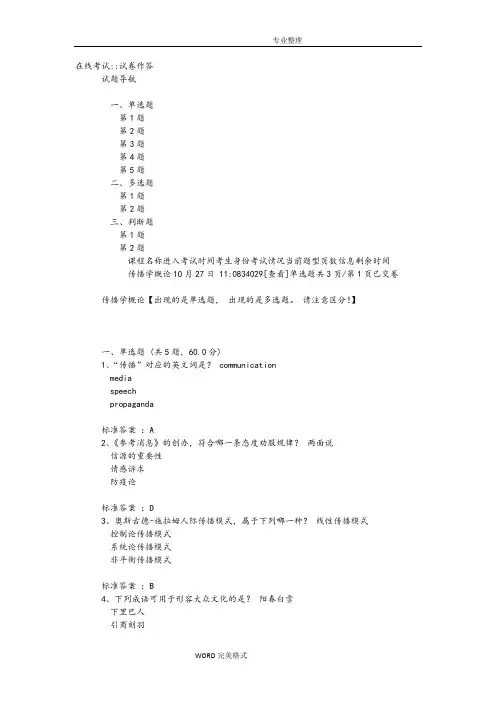
在线考试::试卷作答试题导航一、单选题第1题第2题第3题第4题第5题二、多选题第1题第2题三、判断题第1题第2题课程名称进入考试时间考生身份考试情况当前题型页数信息剩余时间传播学概论10月27日 11:0834029[查看]单选题共3页/第1页已交卷传播学概论【出现的是单选题,出现的是多选题。
请注意区分!】一、单选题 (共5题,60.0分)1、“传播”对应的英文词是? communicationmediaspeechpropaganda标准答案:A2、《参考消息》的创办,符合哪一条态度劝服规律?两面说信源的重要性情感诉求防疫论标准答案:D3、奥斯古德-施拉姆人际传播模式,属于下列哪一种?线性传播模式控制论传播模式系统论传播模式非平衡传播模式标准答案:B4、下列成语可用于形容大众文化的是?阳春白雪下里巴人引商刻羽曲高和寡标准答案:B5、创新扩散研究的一项最有影响的实证研究是?伊里县的总统竞选研究杂交玉米种子推广研究食品习惯改变实验牙齿保健宣传实验标准答案:B提交中,请稍候……交卷在右上角01X在线考试::试卷作答试题导航一、单选题第1题第2题第3题第4题第5题二、多选题第1题第2题三、判断题第1题第2题课程名称进入考试时间考生身份考试情况当前题型页数信息剩余时间传播学概论10月27日 11:0834029[查看]多选题共3页/第2页已交卷传播学概论【出现的是单选题,出现的是多选题。
请注意区分!】二、多选题 (共2题,20.0分)1、下列说法中,关于符号的解说正确的是? "闷雷滚滚,乌云密布"是“下雨”的符号索绪尔将符号分为能指和所指互联网上出现的“火星文”等网络语言,体现了符号的发展性两个人面对面谈话的时候,基本上使用的只有有声语言符号标准答案:B,C2、20世纪20年代,英国广播公司(BBC)确立了公共服务的原则,其原则包括()。
垄断占有在政府控制之下,通过一个独立的委员会来运作,作为国家利益的代理人资金来源是执照费提供一种普遍性的服务标准答案:A,B,C,D提交中,请稍候……交卷在右上角01X在线考试::试卷作答试题导航一、单选题第1题第2题第3题第4题第5题二、多选题第1题第2题三、判断题第1题第2题课程名称进入考试时间考生身份考试情况当前题型页数信息剩余时间传播学概论10月27日 11:0834029[查看]判断题共3页/第3页已交卷传播学概论【出现的是单选题,出现的是多选题。
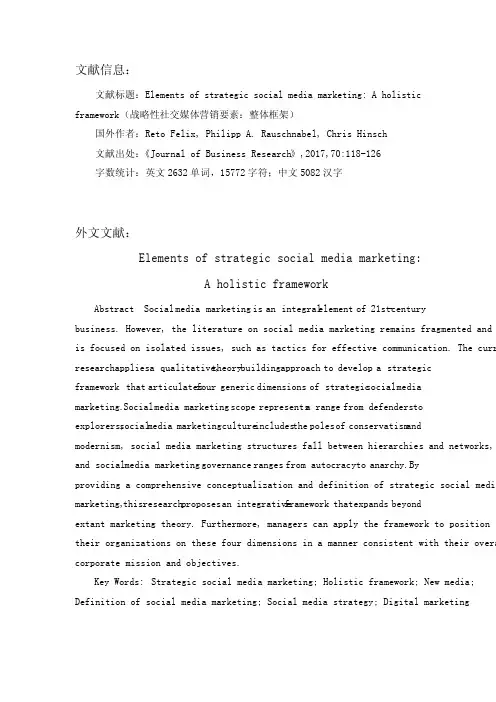
文献信息:文献标题:Elements of strategic social media marketing: A holisticframework(战略性社交媒体营销要素:整体框架)国外作者:Reto Felix, Philipp A. Rauschnabel, Chris Hinsch文献出处:《Journal of Business Research》,2017,70:118-126字数统计:英文2632单词,15772字符;中文5082汉字外文文献:Elements of strategic social media marketing:A holistic frameworkAbstract Social media marketing is an integral element of 21st-centurybusiness. However, the literature on social media marketing remains fragmented and is focused on isolated issues, such as tactics for effective communication. The curr research a pplies a qualitative,theory-building a pproach to develop a strategicfour generic dimensions of strategic social m ediaframework that articulatesmarketing. Social m edia marketing scope represents a range from defenders t osocial media marketing c ulture includes the poles o f conservatism andexplorers,modernism, social media marketing structures fall between hierarchies and networks, and social m edia marketing governance ranges from autocracy t o anarchy. B yproviding a comprehensive conceptualization and definition of strategic social mediaframework that e xpands beyondmarketing, this r esearch proposes a n integrativeextant marketing theory. Furthermore, managers can apply the framework to position their organizations on these four dimensions in a manner consistent with their overa corporate mission and objectives.Key Words: Strategic social media marketing; Holistic framework; New media; Definition of social media marketing; Social media strategy; Digital marketing1.IntroductionUnderstanding the role of social media in the context of marketing is critical f both researchers and managers (e.g. Fong & Burton, 2008; Kumar, Bezawada,2013). Most existingRishika, Janakiraman, &Kannan, 2016; Schultz &Peltier,studies focus on particular issues, such as purchase behavior (Chang, Yu, & Lu, 2015 Kumar et al., 2016; Relling, S chnittka, Sattler, & Johnen, 2016), customerrelationshipmanagement (Trainor, Andzulis, R app, & Agnihotri, 2014), brandmanagement (Asmussen, Harridge-March, Occhiocupo, & Farquhar, 2013),innovation management (Gebauer, Füller, & Pezzei, 2013), and employee recruitment (Sivertzen,Nilsen, & Olafsen, 2013). W hile these s tudies detail advancements inspecialized areas of social media knowledge in a marketing and management context, extant literature does not provide a holistic framework for social media marketing the strategic level. This deficiency is surprising because both academics (Labrecqu vor dem Esche, Mathwick, Novak, & Hofacker, 2013; Schultz & Peltier, 2013; Yadav& Pavlou, 2014) and practitioners (Divol, Edelman, & Sarrazin, 2012) acknowledge new complexities accompanying these m edia and agree that r esearch into s ocialsocial mediastrategicmedia marketing n eeds to be reconceptualized.In a nutshell,marketing remains an untested user interaction paradigm (Naylor, Lamberton, & West, 2012) with little published academic research.The current article aims to address this theoretically and managerially importan research gap by exploring the following two research questions: How is strategicsocial m edia marketing defined a nd conceptualized? and What factors demandsocial media marketing s trategy?an organization'swhen constructingconsiderationSpecifically, this research attempts to define the continua on which critical strat social media marketing decisions lie and to integrate them into a holistic framewor2.MethodologyThe study e mployed a two-stage r esearch design. The first stage c onsisted ofin-depth interviews (Fontana & Frey, 1998) with seven European social m ediaexperience in socialmarketing e xperts who possess b oth national and internationalmedia marketing. Following a purposive sampling strategy (Lincoln & Guba, 1985), experts were recruited according to their job position, experience, and direct expos to social media marketing practices in real industry settings. Seeking depth rather tthe qualitative research breadth, the sample size instage 1 was commensurate with-richparadigm in which relatively small sample sizes are used to generate informationdata (Patton, 1990). A ll informants agreed t o audiotape the i nterviews (between 25and 60 min), which resulted in 117 pages of double-spaced, verbatim transcripts.procedure c onsisted of a qualitative The second stage o f the data collectionsurvey of social media marketing experts (Miles & Huberman, 1994). The survey data were used not for confirmation but as a new and independent qualitative data source with a focus on triangulating the information obtained through the depth interview and online surveys (Jack & Raturi, 2006). Respondents came from a list of 265 social media marketing experts identified through managerially focused magazines, through interviews in business magazines, or because they were mentioned as knowledgeable and experienced experts in personal communication. E-mail requests were sent to allexperts along with two reminders, which resulted in 50 returned surveys (responserate = 18.9%). Seven data s ets w ere eliminated because o f incomplete a nswers orbecause social media marketing plays a minor role in the respondents' daily work. The final sample consisted of 43 respondents (age: m = 37; SD = 9 years; 74% male; 88% European) with various backgrounds in their position and/or industry.Table 1 Summary of stage 2 informantsCompany size (employees)< 50 14 (32.6%)50–99 5 (11.6%)100–499 3 (7.0%)500–9998 (18.6%)1000–4999 6 (14.0%)5000–10,000 3 (7.0%)>10,000 4 (9.3%)Social media marketing experience (in years)Average: 6.4 years1–2 5 (11.6%)3–519 (44.2%)6–812 (27.9%)9 and more 7 (16.3%)Percentage of working time associated with social mediaAverage: 52.8%<20%7 (16.3%)20–3910 (23.3%)40–59 6 (14.0%)60–79 3 (7%)80–10015 (34.9%)n/a 2 (4.7%)Age (in years)Average: 37< 30 9 (20.9%)30–3919 (44.2%)40–4910 (23.3%)50–59 5 (11.6%)Self-reported experience in…Means aSocial Media 6.2Social Media Marketing 5.9Marketing 5.7Customer Management 4.7Advertising 5.2Communications/Public Relations 5.6How much experience do you have in the following areas? (1 = no experience at aall; 7 = highly experienced)Respondents were asked to (1) define s ocial m edia marketing, (2) discussself-selected best and worst practice examples of social media marketing, (3) discusssuccess factors and success m etrics, and (4) d escribe their ideal implementation of-selected organization. The survey employed commonsocial media marketing in a self& Mcbride, 2009), s uch as addingdesign t echniques (Smyth, Dillman, C hristian,large answer fields and asking respondents to be as specific as possible, to increrespondents' motivation to provide detail.3.FindingsFig. 1 shows the strategic social media marketing framework with its four central dimensions.Fig. 1. Strategic social media marketing framework.social media marketing s cope addresses the question whether companies First,use social media marketing p redominantly for communication with one or a fewstakeholders or comprehensively (both externally and internally) as a genuine tool f Defenders use social m edia marketing primarily a s a one-waycollaboration.rather than communication tool t o entertainconsumers or to inform stakeholders,groups. Conversely, explorers are interested in integrating employees or communityan authentic social media marketing c ollaborationinteractionsbased on reciprocalwith many different stakeholders such as clients, employees, suppliers, andgovernment agents.between conservatism, Second, social media marketing c ulture distinguishesapproach t owhich is represented by an encapsulated,mass advertisingtraditional,social media marketing, and modernism, which is characterized by a more permeable,open, and flexible social media marketing culture.Third, social media marketing structure addresses the organization and departmentalization of the social media marketing assignment in the firm. Hierarchieapproach with a clearly defined s ocial media marketingstand for a centralizedassignee. Networks represent an organizational structure in which all employees are responsible for social media marketing, and thus a dedicated social media marketing director is no longer necessary.Fourth, social m edia marketing governance refers t o how the companyestablishes rules and guidelines and how social media marketing responsibilities ar controlledin the company. The extreme position of autocracy describes a situationwith precise regulations on who in the company is allowed to interact on social medi platforms. Conversely, anarchy represents a situation without any such rules o rguidelines.The current research focuses on the extremes of each continuum, but, in general, firms likely choose (intentionally or unintentionally) a position somewhere between the poles o n each dimension. For example, c ompanies need to find a position onsocial media marketing g overnance t hat neither regulates everything employees areallowed to say nor leaves t hem without any guidance on which to base their responsibilitiesor behaviors. Fig. 1 also suggests that d ecisions on social mediageneral(e.g.,marketing s hould i ndeed b e guided by the firm's internalinfluencersvision, mission, corporate goals, corporate culture, available resources), which in should be in line with external i nfluencers (e.g., communities, competition,government regulation).4.Discussion and implicationsThis research addresses the absence of a holistic framework for strategicsocialreveals several approachesmedia marketing. A review of the marketing l iteraturemanagementregarding aspects of strategicmarketing s uch as customer r elationship(e.g., Payne & Frow, 2005) or marketing organization (Workman, Homburg, &Gruner, 1998). However, few articles address the strategic marketing of social mediaand none put forth a holistic social media marketing framework.While extant research related to social media marketing investigates social media mostly through the lens of a particular marketing problem (e.g. Fong & Burton, 2008; Kim & Ko, 2012; Kumar et al., 2016) or witha focus on customers and communication (e.g., Chang et al., 2015), t he findings of this s tudy reveal f ourgeneral social m edia marketing dimensions that firms should address when conceptualizing or managing their strategic social media marketing approach. As the findings indicate, these dimensions are interdependent, and companies should strive position themselves on the four dimensions in an integrated way, rather than treati them as isolated, independent decisions.4.1.A new definition of social media marketingThis research suggests a new definition of social media marketing: Social media-functional concept that uses social media marketing is an interdisciplinary and cross(often in combination with other communications channels) to achieve organizational goals by creating value for stakeholders. On a strategic level, social media marketi covers an organization's decisions about social media marketing scope (ranging from defenders to explorers), culture (ranging from conservatism to modernism), structurto networks), and governance (ranging from autocracy to(ranging from hierarchiesanarchy).4.2.Implications for social media marketing scopeSocial media marketing provides firms with an opportunity to use social media to with customers, employees, communities, and other stakeholdersbuild relationships(i.e., when they act as explorers). At the same time, firms may choose to view soci media as simply another c ommunications channel through which they can pushwhen they act as defenders). Though potentiallyinformation to customers (i.e.,approach does nottake advantage of thefor c ustomers, the defendercreating valuewithin the network of customers,opportunitiesfor building r eal relationshipsemployees, interest groups, the government, and other stakeholders, as propagated by modern relationshipmarketing (Payne & Frow, 2005). However, the explorerstakeholders in theapproach may require firms to redefine the role o f differentorganization.4.3.Implications for social media marketing cultureManagement and organizational behavior researchers (Zheng et al., 2010) as well as marketing academics and practitioners (Deshpandé & Farley, 2004) recognize the-financial firmimportance of culture and organizational climate for financial and non performance. The current research emphasizes t he importance o f culture for s ocialmedia marketing. Companies engaging in social media marketing must acknowledgethat stakeholders can take control of and manipulate social media content (Labrecque et al., 2013). Thus, companies should contemplate t he trade-offs between anwhich provides m oreencapsulated social media marketing c ulture (conservatism),connect a nd engageand consumers' desire tobrand constructs,control of importantwith firms displaying a more progressive, permeable culture (i.e., modernism).4.4.Implications for social media marketing structureExtant marketing research investigates how the elements of marketing should besuch as formalization,characteristics,organized a ccording t o a firm's structural(e.g.,Olson, S later, & Hult, 2005). C onsequently,and specializationcentralization,and organizationalsocial m edia marketing structure focuses on responsibilitiesemployed to configure social media marketing. Whereas social mediahierarchiesmarketing governance pertains to who can or should say what in social media, social media marketing structure focuses on who has the responsibility to post and interac in these m edia. A s the informants emphasized, firms s hould i ntegratesocial mediaThe informantsmarketing in a way that fits with their o verarching strategies.or asets o f benefits that c an emerge from either a hierarchicalidentifieddifferentnetworked structure. However, they recommended that specific decisions about who has the responsibility to interact online with customers, activists, and pundits sh be formally discussed in the organization.4.5.Implications for social media marketing governancerights, and Research on governance usually investigates the structures,responsibilities among different employees in organizations (Freeman & Reed, 1983).-discipline of corporate governance, Information technology (IT) governance, as a subfocuses on specifying which individuals have the responsibility for making decisions on the use of IT (Brown & Grant, 2005). Whereas IT governance traditionally focuses-related purposes, social media can potentially be used byon the use of IT for work(company-granted a ccess) or unofficial(personalany employee in either officialaccount access) capacities. Therefore, the applicability of IT governance research is limited u se when extended to social m edia marketing. S ome companies havedeveloped the idea of educating e mployees about the personal a nd firm-related consequences of “undesirable” social media use through social mediamarketingguidelines andguidelines(Linke &Zerfass, 2013). However, building social mediagovernance into a holistic framework for social media marketing is novel. The role o employees in promoting brands in other contexts (and thus increasing firm value) is(Morhart, Herzog, & Tomczak, 2009).well represented in the academic literatureWeber Shandwick's (2014) recent s tudy reveals a n emerging movement termed“employee activism” in which one-third of the surveyed respondentswere socialwho defended their employers and advocated f or the firm online.media activistsEmployees may be better able to understand the needs of consumers and products that can meet those needs, and they can effectively advocate and promote the firm online. These technologiesall employees to champion the firm. Forhave allowed v irtuallyNordstrom has policies to provide e mployees withexample, the fashion r etailerof social media marketingThis applicationand expectations.knowledge, d irection,governance can increase the overall social media marketing s uccess o f the firm (Nordstrom, 2015; Ross, Beath, & Sebastian, 2015).5.Limitations and future researchavenues forfruitfulSeveral limitationsto the current study s uggest p otentiallyapproach r eveals four d imensions o f strategicfuture research. First, the qualitativesocial media marketing and identifies the extreme points of each dimension. However,of differentto identify the impactfuture researchcould u se quantitative approachespositions on each of these dimensions. Research could also investigate the influenc of each dimension on firm or social media marketing p erformance. For example,studies could try to isolate the effect of each dimension on outcome variables such2013) or, m ore specifically,newconsumer–brand engagement (Schultz & Peltier,is themedia brand engagement (Hennig-Thurau et al., 2010). A second limitationover-representation of European (especially German) informants in the analyses. Prior research d iscusses cross-cultural differences in consumers' u se of social m edia(Bernoff &Li, 2008; World Newsmedia Network, 2015). Furthermore, extantresearch advocates for the adaptation of social media content to the targeted cult(Tsai &Men, 2012). T hus, caution should b ebased on differingconsumer profilestaken in extrapolating the framework to other cultural contexts. Future research mig determine w hether aspects of cultural or economic context add dimensions t o theapproaches r egardingproposed f ramework or whether they simply require differentthe four dimensions.Future research should also investigate how other characteristics, such as cultur the type of firm (e.g., B2B vs. B2C), the industry (e.g., financial services vs.“idealadvertising agency), company size, or available resources, influence a firm'ssocial media marketing. Finally,position” on each of the dimensions o f strategic-regulatory bodies (e.g.,future research could investigate the role of regulatory or selfon social media marketing g overnance a ndWord of Mouth Marketing A ssociation)how firms can create v alue and form core competencies b y superseding t hese requirements.6.ConclusionThis study sheds light on the complex nature of strategic social media marketingis too complex to be managed and executedSocial m edia marketing, in practice,-functional collaborations exclusively by a single individual or even department. Crossalong the four d imensions o f social media marketing a re necessary to successfullynavigate in this dynamic arena.中文译文:战略性社交媒体营销要素:整体框架 摘要 社交媒体营销是21世纪商业的一个组成部分。
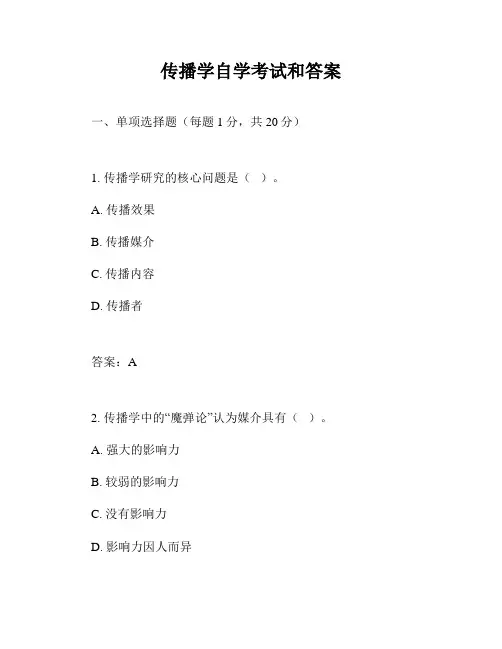
传播学自学考试和答案一、单项选择题(每题1分,共20分)1. 传播学研究的核心问题是()。
A. 传播效果B. 传播媒介C. 传播内容D. 传播者答案:A2. 传播学中的“魔弹论”认为媒介具有()。
A. 强大的影响力B. 较弱的影响力C. 没有影响力D. 影响力因人而异答案:A3. 传播学中的“两步流”理论是由()提出的。
A. 拉斯韦尔B. 拉扎斯菲尔德C. 霍夫兰D. 麦克卢汉答案:B4. 传播学中的“沉默的螺旋”理论是由()提出的。
A. 诺依曼B. 麦克卢汉C. 霍夫兰D. 拉斯韦尔答案:A5. 传播学中的“议程设置”理论是由()提出的。
A. 麦克卢汉B. 诺依曼C. 霍夫兰D. 科恩答案:D6. 传播学中的“使用与满足”理论是由()提出的。
A. 麦克卢汉B. 卡茨C. 霍夫兰D. 拉斯韦尔答案:B7. 传播学中的“框架理论”是由()提出的。
A. 贝特森B. 戈夫曼C. 霍夫兰D. 麦克卢汉答案:B8. 传播学中的“认知失调”理论是由()提出的。
A. 费斯汀格B. 麦克卢汉C. 霍夫兰D. 拉斯韦尔答案:A9. 传播学中的“社会学习”理论是由()提出的。
A. 班杜拉B. 麦克卢汉C. 霍夫兰D. 拉斯韦尔答案:A10. 传播学中的“传播效果”可以分为()。
A. 短期效果和长期效果B. 直接效果和间接效果C. 个人效果和社会效果D. 所有上述选项答案:D11. 传播学中的“传播媒介”可以分为()。
A. 个人媒介和大众媒介B. 印刷媒介和电子媒介C. 传统媒介和新媒体D. 所有上述选项答案:D12. 传播学中的“传播内容”可以分为()。
A. 信息和符号B. 事实和意见C. 娱乐和教育D. 所有上述选项答案:D13. 传播学中的“传播者”可以分为()。
A. 个人和群体B. 组织和机构C. 媒体和非媒体D. 所有上述选项答案:D14. 传播学中的“受众”可以分为()。
A. 个人和群体B. 被动和主动C. 传统和现代D. 所有上述选项答案:D15. 传播学中的“传播环境”可以分为()。
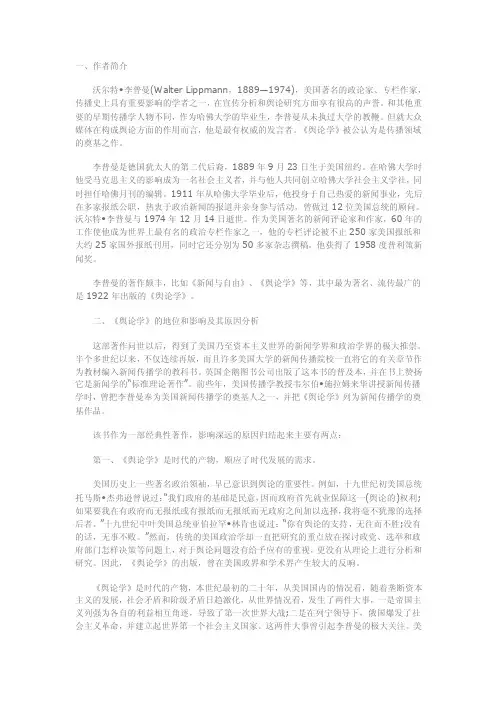
一、作者简介沃尔特•李普曼(Walter Lippmann,1889—1974),美国著名的政论家、专栏作家,传播史上具有重要影响的学者之一,在宣传分析和舆论研究方面享有很高的声誉。
和其他重要的早期传播学人物不同,作为哈佛大学的毕业生,李普曼从未执过大学的教鞭。
但就大众媒体在构成舆论方面的作用而言,他是最有权威的发言者。
《舆论学》被公认为是传播领域的奠基之作。
李普曼是德国犹太人的第二代后裔,1889年9月23日生于美国纽约。
在哈佛大学时他受马克思主义的影响成为一名社会主义者,并与他人共同创立哈佛大学社会主义学社,同时担任哈佛月刊的编辑。
1911年从哈佛大学毕业后,他投身于自己热爱的新闻事业,先后在多家报纸公职,热衷于政治新闻的报道并亲身参与活动,曾做过12位美国总统的顾问。
沃尔特•李普曼与1974年12月14日逝世。
作为美国著名的新闻评论家和作家,60年的工作使他成为世界上最有名的政治专栏作家之一,他的专栏评论被不止250家美国报纸和大约25家国外报纸刊用,同时它还分别为50多家杂志撰稿。
他获得了1958度普利策新闻奖。
李普曼的著作颇丰,比如《新闻与自由》、《舆论学》等,其中最为著名、流传最广的是1922年出版的《舆论学》。
二、《舆论学》的地位和影响及其原因分析这部著作问世以后,得到了美国乃至资本主义世界的新闻学界和政治学界的极大推崇。
半个多世纪以来,不仅连续再版,而且许多美国大学的新闻传播院校一直将它的有关章节作为教材编入新闻传播学的教科书。
英国企鹅图书公司出版了这本书的普及本,并在书上赞扬它是新闻学的“标准理论著作”。
前些年,美国传播学教授韦尔伯•施拉姆来华讲授新闻传播学时,曾把李普曼奉为美国新闻传播学的奠基人之一,并把《舆论学》列为新闻传播学的奠基作品。
该书作为一部经典性著作,影响深远的原因归结起来主要有两点:第一、《舆论学》是时代的产物,顺应了时代发展的需求。
美国历史上一些著名政治领袖,早已意识到舆论的重要性。
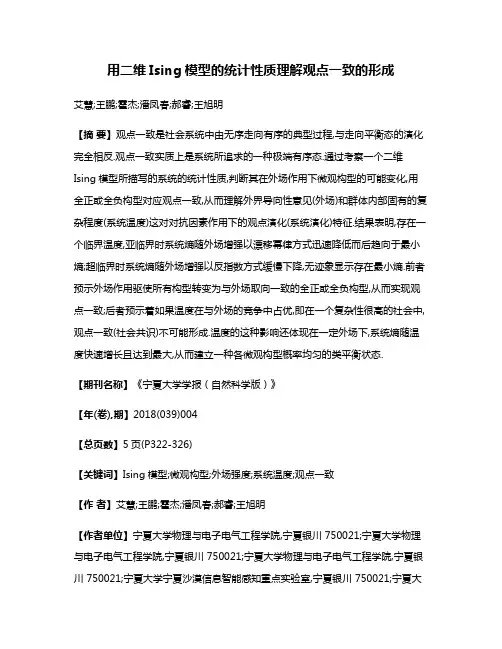
用二维Ising模型的统计性质理解观点一致的形成艾慧;王鹏;霍杰;潘凤春;郝睿;王旭明【摘要】观点一致是社会系统中由无序走向有序的典型过程,与走向平衡态的演化完全相反.观点一致实质上是系统所追求的一种极端有序态.通过考察一个二维Ising模型所描写的系统的统计性质,判断其在外场作用下微观构型的可能变化,用全正或全负构型对应观点一致,从而理解外界导向性意见(外场)和群体内部固有的复杂程度(系统温度)这对对抗因素作用下的观点演化(系统演化)特征.结果表明,存在一个临界温度,亚临界时系统熵随外场增强以漂移幂律方式迅速降低而后趋向于最小熵;超临界时系统熵随外场增强以反指数方式缓慢下降,无迹象显示存在最小熵.前者预示外场作用驱使所有构型转变为与外场取向一致的全正或全负构型,从而实现观点一致;后者预示着如果温度在与外场的竞争中占优,即在一个复杂性很高的社会中,观点一致(社会共识)不可能形成.温度的这种影响还体现在一定外场下,系统熵随温度快速增长且达到最大,从而建立一种各微观构型概率均匀的类平衡状态.【期刊名称】《宁夏大学学报(自然科学版)》【年(卷),期】2018(039)004【总页数】5页(P322-326)【关键词】Ising模型;微观构型;外场强度;系统温度;观点一致【作者】艾慧;王鹏;霍杰;潘凤春;郝睿;王旭明【作者单位】宁夏大学物理与电子电气工程学院,宁夏银川 750021;宁夏大学物理与电子电气工程学院,宁夏银川 750021;宁夏大学物理与电子电气工程学院,宁夏银川 750021;宁夏大学宁夏沙漠信息智能感知重点实验室,宁夏银川 750021;宁夏大学物理与电子电气工程学院,宁夏银川 750021;宁夏大学物理与电子电气工程学院,宁夏银川 750021;宁夏大学宁夏沙漠信息智能感知重点实验室,宁夏银川 750021;宁夏大学物理与电子电气工程学院,宁夏银川 750021;宁夏大学宁夏沙漠信息智能感知重点实验室,宁夏银川 750021【正文语种】中文【中图分类】O415;N949近年来,观点演化等社会系统的集体行为日益成为备受关注的研究焦点,物理学为该研究提供了深刻的思想和独特的视角.Martins在Bayesian统计理论的基础上赋予观点以惯性、位移、速度等物理概念[1—4],建立类牛顿第二定律的粒子化观点动力学模型.Helbing引入社会力的概念研究人类行走的时空特征,引入心理力、物理力和势场等概念构建惶恐状态下的人群逃散模型[5—6].Castellano等引入平均场近似,研究由文化元素同一性所标志的区域文化有序性和由文化元素差异所标志的区域文化无序性之间的相变关系[7].Comincioli,Düring等先后引入Boltzmann方程用以描写社会观点的演化[8—9],方程的碰撞项对应观点演化过程中个体间的自我思考或坚持己见(self-thinking)和意见交换或意见妥协(opinion exchange),分别体现领导者和追随者在相互作用中的角色地位.这些工作旨在将人类作为一类对象,纳入物理学的理论框架之中,把人与自然物质(物体)统一起来,理解其行为及其机制.然而,这样的尝试极具挑战性.作为成功描述铁磁相变的Ising模型,因其粒子具有正负两种自旋取向,天然具有模拟正反两种观点演化的功能.Sznajd等成功改造了Ising模型,用以模拟观点演化.首先是传教士模型,若两邻居观点一致,则说服所有听者采纳相同观点;若两邻居观点相左,则导致听者无所适从而不改变观点[10—11].其次是金融市场模型,体现对商品价值的判断在诸贸易参与者之间的传播,最后形成价格的过程[12].再次是社会价值取向模型,两类自旋态分别代表经济领域中任何两种相反的观点和由个人世界观、价值观和人生观决定的不同取向,用以研究个人社会价值取向和有关经济问题观点之间的相互作用对形成社会共识的影响[13].此外,Krause与Hegselmann提出的磋商者模型[14]和Deffuant建议的机会主义模型[15],分别针对观点演化的不同情形,提取本质特征.前者中每一个体将征询所有邻居意见并取平均;后者中每一个体选择一个对话伙伴,若对话双方意见相差在信任限度之内,则双方调整意见,彼此更加接近.基于Ising模型的这些工作,能够再现观点一致、两极分化或多种观点并存等情形.笔者通过考察一个由二维Ising模型所描述的系统处于外磁场中的整体(熵)变化趋势,理解在外界导向性意见影响下的观点演化.重点考察外场强度和系统温度的影响.前者代表来自外界的导向性影响,或正或负;后者代表系统的复杂程度,温度越高,个体间差异性越大,个性特征越丰富,系统越复杂.1 二维Ising模型的微观构型及其所描述的系统图1表示一个由圆圈代表粒子/个体的n×m二维点阵.每个粒子/个体携带自旋向上或向下/观点为正或为负的状态,分别用+1和-1表示.网格线代表相邻粒子/个体之间的相互作用,强度为J.在外场强度为B、系统温度为T的条件下,考虑近邻相互作用的系统,其第L种微观构型的Hamilton可写为Jij,i(j-1)sijsi(j-1)+Jij,i(j+1)sijsi(j+1))-(1)式中:sij为第i行第j列节点上粒子/个体所携带的状态,即sij=±1;Jij,mn为第i行第j列节点与第m行第n列节点之间的相互作用强度.假设网格节点遵从周期性边界条件(2)及(3)则以此为微观态的系统配分函数Z为(4)式中:N=m×n;kB为玻尔兹曼常数,文中取1;T为系统温度.如前所述,这里的温度,从统计的角度说,是对系统复杂程度的描述,温度越高,系统内部越复杂.对于一个确定构型,其出现的概率为(5)由此给出系统的熵S(6)通过考察系统的S随T,B的变化,揭示系统的整体变化,从而理解每个微观构型的可能变化.图1 二维Ising模型示意及其格点编号方式2 系统的统计特征与观点演化从统计的角度分析,观点演化实质是其他微观构型向一种目标微观构型的转变,使之概率最大化的过程.微观构型的转变将引起系统S的变化,反之,系统S的变化即反映微观构型的变化.因此,对观点演化过程的刻画就转变为对微观构型的描述.为便于描述(图1),对网格节点进行编号排序,从右下角到左上角依次对格点赋予编号(m×n)(m×n-1)(m×n-2)…321,同时,将节点所携带的状态+1和-1分别用二进制数1和0代替.于是,不同的微观构型就可以转化为相应的二进制数,用L来表示,L=0对应的二进制数000…000表示所有节点的状态为-1,L=1对应的二进制数000…001表示的是编号为1的节点状态为+1、其他节点的状态为-1.以此类推,二进制数111…111表示所有节点状态为+1.系统S需借助计算2N个微观构型构的配分函数即分布概率得到.数据的量级巨大,故文中选择4×4的网格作为算例.图2显示在个体间耦合强度J=5.0、确定温度下,S随外场强度B的变化.不同温度下,S均随B的增强而下降,温度较低时,S-B曲线呈现凹型,温度较高时呈现凸型,凸凹转变的临界温度大约为Tc=5(图2b).由T=1时S-B曲线可知,温度较低时,S随B以漂移幂律的方式下降,即有S=(B+a)-α ,(7)式中:a=1.07,α=2.08.由T=20时S-B曲线可知,温度较高时,S随B以“反指数”方式下降,即S=c-b·eB/γ ,(8)式(8)中:c=11.1,b=0.03,γ=13.3.式中,主导变化趋势的项是-eB/γ,是对正指数项引入了一个负号,故称作“反指数”项,表明熵函数整体呈现反指数下降趋势. 图2 不同温度下熵随外场强度的变化不论以漂移幂律方式下降还是反指数方式下降,S随B的增强而减小,说明系统的有序性增强.可以依据这种有序变化判断系统各微观构型的变化.随着B的增强,越来越多的微观构型转变为同外场一致的全正构型(B>0时,每个格点粒子自旋均为正)或全负构型(B<0时,每个格点粒子自旋均为负).这个结论证实,当B为正时,随B的增强全正构型的概率迅速提高且呈压倒性优势,全负构型的概率几近为零,其他构型的概率急剧降低.将这种变化与观点演化过程相对应,作为外界引导性意见的B,其强度的增大,意味着越来越多的个体观点将被强大的外界舆论导向“拖拉”为一致,系统的S随之降低.问题是,为什么会存在2种下降方式?2者有什么本质区别?首先要强调的是温度T和B是一对矛盾对抗的因素,T越高系统越无序,越难形成观点一致;B越强,系统越有序,全正/全负构型出现的概率越大,越容易形成观点一致.当T较低时(图2a),S随B增强以近似为幂律的方式迅速下降,并很快达到一个趋近于零的很小值.表明该情况下,T的影响随着B增强快速地退居其次,B起主导作用,促使所有个体迅速形成一致,其标志是S达到相对稳定的最小值.由图2可知,随着T的升高,S的下降趋势逐渐变缓,说明T的影响趋于明显,并与B形成竞争态势.当升高到Tc时,竞争双方势均力敌.超过Tc时,T的影响强于B的影响(图2c),S 随B增强以反指数的方式缓慢下降,T越高越缓慢.显然不可能存在一个渐近的稳定状态,使S降到最低.表明高温主导下的系统,不论B强到什么程度,都不会形成观点一致.对应于观点演化,T实质代表了群体内部由世界观、价值观、人生观、文化习俗等诸多因素决定的个体差异的大小程度以及多样性等性质.T越高,个体间固有的差异性越大,多样性更加丰富.在B一定的情况下,这种性质突出表现在系统的S随T升高而升高的变化关系中.图3显示在B=10,30,50下,系统的S随T的升高单调递增的情形.确定外场下,T升高系统的S迅速增加,并最终趋于一个相对稳定的最大值,即在S-T曲线上存在一个迅速上升和逼近于此相对稳定最大值的拐点.越过此拐点即标志着系统建立了S达到最大的无序态,即一个类平衡态(系统各微观构型的概率趋于均匀).当确定的B增大时,最明显的变化是S-T曲线上的拐点向下、向右移动,表明较强的B迟滞了类平衡态的建立.但是,仅仅是迟滞而非阻止. 图3 不同的外场强度下熵随温度的变化3 结论与讨论文中引入一个满足周期性边界条件的二维Ising模型所描述的系统,自旋为+1和-1的粒子占据格点位置的排列即为系统的微观构型,全正构型和全负构型可分别对应一致的正、反观点.重点考察外场强度B和系统温度T对由熵S描写的系统整体行为的影响,从而借助于S的变化实现对观点演化的新理解.外场B和系统T在这里是一对矛盾对抗因素,前者代表来自外界的导向性影响的强度,后者代表系统的复杂程度,T越高,个体间固有的差异性越大,个性特征越丰富,系统越复杂;前者驱动个体趋于一致,后者压制一致性的形成.2因素竞争旗鼓相当时存在一临界温度Tc,在亚临界条件下,S随B增强以漂移幂律方式迅速下降并趋于最小值,标志着所有微观构型转变为全正或全负构型,使系统的S 达到最小;在Tc下,S随B以反指数方式缓慢下降且不存在最小值,无法实现一致性.有趣的是,临界条件由近乎为直线的S-B图线所标志,亚临界和超临界分别由凹和凸的S-B图线所标志.这意味着亚临界温度区存在无序—有序相变,而超临界温度区不存在相变.该结论与Ising模型的早期结果一致.系统T的上述性质,在B一定的S-T图线上表现得非常明显,曲线在T较低时非常陡峭,并随T迅速趋向一个最大S,标志着各种构型概率相当的准平衡态的建立.总之,T越高,个体间的固有差异性越大且个性越丰富,难以形成观点一致;B越强,外界的导向性影响越强,越容易实现观点一致.另外,本文有2个重要启示,一是借助Ising模型的统计性质,可获得对观点一致更为深刻的理解;一是借助于统计物理方法可以获得对复杂演化过程的描述,避免在建立演化规则进行动力学模拟时引入过多的唯象性和片面性.参考文献:【相关文献】[1] MARTINS A C R. Opinion particles: Classical physics and opinion dynamics[J]. Physics Letters A,2015,379(3):89-94.[2] JAYNES E T, BRETTHORST G L. Probability theory: the logic of science[M]. England :Cambridge University Press,2003.[3] COX R T, JAYNES E T. The algebra of probable inference[M]. America :The Johns HOPKINS,1961.[4] MARTINS A C R. Bayesian updating rules in continuous opinion dynamics models[J]. Journal of Statistical Mechanics: Theory & Experiment,2009(2):57-75.[5] HELBING D, MOLNR P. Social force model for pedestrian dynamics[J]. Physical Review E: Statistical Physics Plasmas Fluids & Related Interdisciplinary Topics,1995,51(5):4282. [6] HELBING D, FARKAS I, VICSEK T. Simulating dynamical features of escape panic[J]. Nature,2000,407(6803):487-490[7] CASTELLANO C, MARSILI M, VESPIGNANI A. Nonequilibrium phase transition in a model for social influence[J]. Physical Review Letters,2000,85(16)3536-3539.[8] COMINCIOLI V, DELLA CROCE L, TOSCANI G. A Boltzmann-like equation for choice formation[J]. Kinetic & Related Models,2017,2(1):135-149.[9] DüRING B, MARKOWICH P, PIETSCHMANN J F, et al. Boltzmann and Fokker-Planck equations modelling opinion formation in the presence of strong leaders[J].Proceedings Mathematical Physical & Engineering Sciences,2009,465(2112):3687-3708.[10] SZNAJD-WERON K, SZNAJD J. Opinion evolution in closed community[J]. International Journal of Modern Physics C,2001,11(6):1157-1165.[11] STAUFFER D, SOUSA A O, DE OLIVEIRA S M. Generalization to square lattice of sznajd sociophysics model[J]. International Journal of Modern Physics C,2000,11(6):1239-1245.[12] SZNAJD-WERON K, WERON R. A simple model of price formation [J]. International Journal of Modern Physics C,2002,13(1):115-123.[13] SZNAJD-WERON K, SZNAJD J. Who is left, who is right? [J]. Physica A: Statistical Mechanics & Its Applications,2005,351(2/4):593-604.[14] HEGSELMANN R, KRAUSE U. Opinion dynamics and bounded confidence models, analysis and simulation[J]. Journal of Artificial Societies & Social Simulation,2002,5(3):2. [15] AMBLARD F, DEFFUANT G, WEISBUCH G. How can extremism prevail? A study basedon the relative agreement interaction model[J]. Journal of Artificial Societies & Social Simulation,2002,5(4):1.。
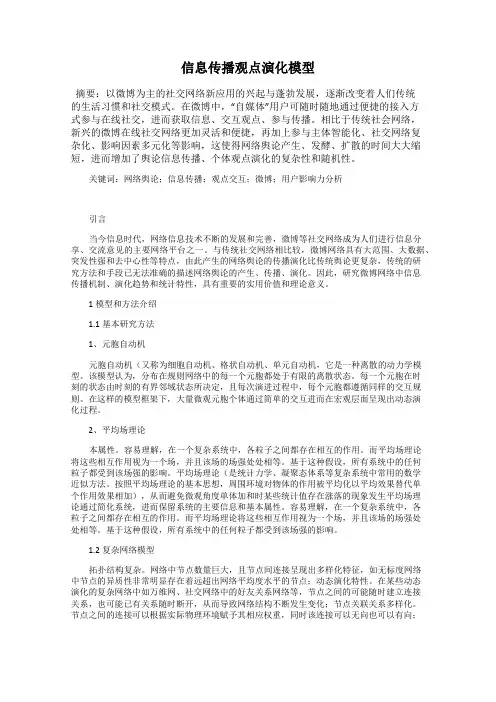
信息传播观点演化模型摘要:以微博为主的社交网络新应用的兴起与蓬勃发展,逐渐改变着人们传统的生活习惯和社交模式。
在微博中,“自媒体”用户可随时随地通过便捷的接入方式参与在线社交,进而获取信息、交互观点、参与传播。
相比于传统社会网络,新兴的微博在线社交网络更加灵活和便捷,再加上参与主体智能化、社交网络复杂化、影响因素多元化等影响,这使得网络舆论产生、发酵、扩散的时间大大缩短,进而增加了舆论信息传播、个体观点演化的复杂性和随机性。
关键词:网络舆论;信息传播;观点交互;微博;用户影响力分析引言当今信息时代,网络信息技术不断的发展和完善,微博等社交网络成为人们进行信息分享、交流意见的主要网络平台之一。
与传统社交网络相比较,微博网络具有大范围、大数据、突发性强和去中心性等特点,由此产生的网络舆论的传播演化比传统舆论更复杂,传统的研究方法和手段已无法准确的描述网络舆论的产生、传播、演化。
因此,研究微博网络中信息传播机制、演化趋势和统计特性,具有重要的实用价值和理论意义。
1模型和方法介绍1.1基本研究方法1、元胞自动机元胞自动机(又称为细胞自动机、格状自动机、单元自动机,它是一种离散的动力学模型。
该模型认为,分布在规则网络中的每一个元胞都处于有限的离散状态。
每一个元胞在时刻的状态由时刻的有界邻域状态所决定,且每次演进过程中,每个元胞都遵循同样的交互规则。
在这样的模型框架下,大量微观元胞个体通过简单的交互进而在宏观层面呈现出动态演化过程。
2、平均场理论本属性。
容易理解,在一个复杂系统中,各粒子之间都存在相互的作用。
而平均场理论将这些相互作用视为一个场,并且该场的场强处处相等。
基于这种假设,所有系统中的任何粒子都受到该场强的影响。
平均场理论(是统计力学、凝聚态体系等复杂系统中常用的数学近似方法。
按照平均场理论的基本思想,周围环境对物体的作用被平均化以平均效果替代单个作用效果相加),从而避免微观角度单体加和时某些统计值存在涨落的现象发生平均场理论通过简化系统,进而保留系统的主要信息和基本属性。
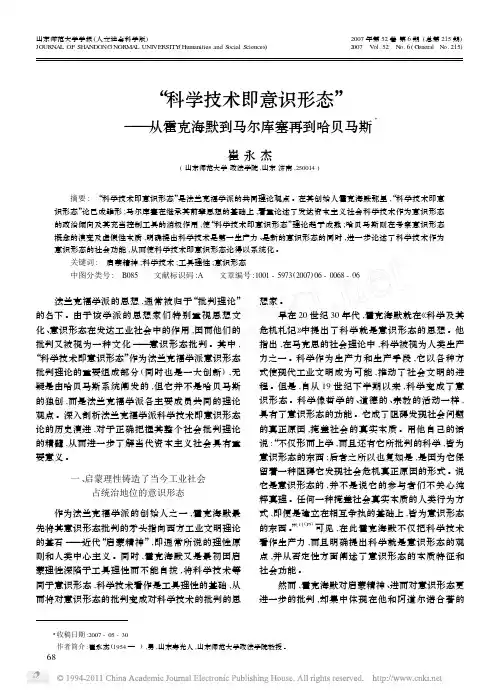
山东师范大学学报(人文社会科学版) JOURNA L OF SH ANDONG NOR M A L UNIVERSITY (Humanities and S ocial S ciences ) 2007年第52卷第6期(总第215期)2007 V ol.52 N o.6(G eneral N o.215)“科学技术即意识形态”———从霍克海默到马尔库塞再到哈贝马斯3崔永杰(山东师范大学政法学院,山东济南,250014) 摘要: “科学技术即意识形态”是法兰克福学派的共同理论观点。
在其创始人霍克海默那里,“科学技术即意识形态”论已成雏形;马尔库塞在继承其前辈思想的基础上,着重论述了发达资本主义社会科学技术作为意识形态的政治倾向及其充当控制工具的消极作用,使“科学技术即意识形态”理论趋于成熟;哈贝马斯则在考察意识形态概念的演变及虚假性本质,明确提出科学技术是第一生产力、是新的意识形态的同时,进一步论述了科学技术作为意识形态的社会功能,从而使科学技术即意识形态论得以系统化。
关键词: 启蒙精神;科学技术;工具理性;意识形态中图分类号: B085 文献标识码:A 文章编号:1001-5973(2007)06-0068-063收稿日期:2007-05-30作者简介:崔永杰(1954— ),男,山东寿光人,山东师范大学政法学院教授。
法兰克福学派的思想,通常被归于“批判理论”的名下。
由于该学派的思想家们特别重视思想文化、意识形态在发达工业社会中的作用,因而他们的批判又被视为一种文化———意识形态批判。
其中,“科学技术即意识形态”作为法兰克福学派意识形态批判理论的重要组成部分(同时也是一大创新),无疑是由哈贝马斯系统阐发的,但它并不是哈贝马斯的独创,而是法兰克福学派各主要成员共同的理论观点。
深入剖析法兰克福学派科学技术即意识形态论的历史演进,对于正确把握其整个社会批判理论的精髓,从而进一步了解当代资本主义社会具有重要意义。
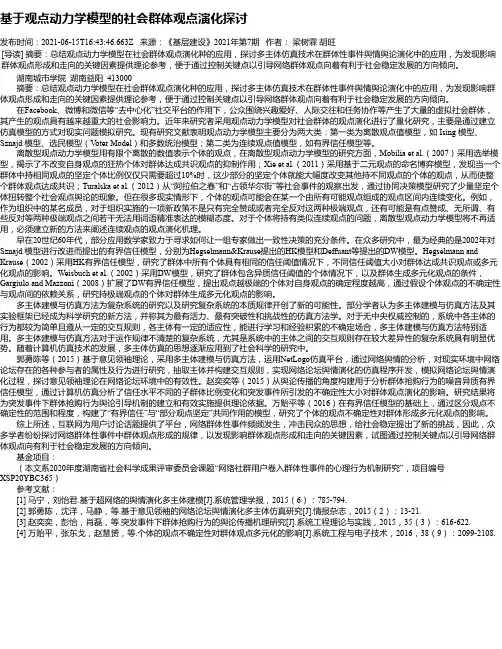
基于观点动力学模型的社会群体观点演化探讨发布时间:2021-06-15T16:43:46.663Z 来源:《基层建设》2021年第7期作者:梁树霖胡旺[导读] 摘要:总结观点动力学模型在社会群体观点演化种的应用,探讨多主体仿真技术在群体性事件舆情舆论演化中的应用,为发现影响群体观点形成和走向的关键因素提供理论参考,便于通过控制关键点以引导网络群体观点向着有利于社会稳定发展的方向倾向。
湖南城市学院湖南益阳 413000摘要:总结观点动力学模型在社会群体观点演化种的应用,探讨多主体仿真技术在群体性事件舆情舆论演化中的应用,为发现影响群体观点形成和走向的关键因素提供理论参考,便于通过控制关键点以引导网络群体观点向着有利于社会稳定发展的方向倾向。
在Facebook、微博和微信等“去中心化”社交平台的作用下,公众围绕兴趣爱好、人际交往和任务协作等产生了大量的虚拟社会群体,其产生的观点具有越来越重大的社会影响力。
近年来研究者采用观点动力学模型对社会群体的观点演化进行了量化研究,主要是通过建立仿真模型的方式对现实问题模拟研究。
现有研究文献表明观点动力学模型主要分为两大类:第一类为离散观点值模型,如 Ising 模型、Sznajd 模型、选民模型(V oter Model)和多数统治模型;第二类为连续观点值模型,如有界信任模型等。
离散型观点动力学模型用有限个离散的数值表示个体的观点,在离散型观点动力学模型的研究方面,Mobilia et al.(2007)采用选举模型,揭示了不改变自身观点的狂热个体对群体达成共识观点的抑制作用;Xie et al.(2011)采用基于二元观点的命名博弈模型,发现当一个群体中持相同观点的坚定个体比例仅仅只需要超过10%时,这少部分的坚定个体就能大幅度改变其他持不同观点的个体的观点,从而使整个群体观点达成共识;Turalska et al.(2012)从“阿拉伯之春”和“占领华尔街”等社会事件的观察出发,通过协同决策模型研究了少量坚定个体扭转整个社会观点舆论的现象。
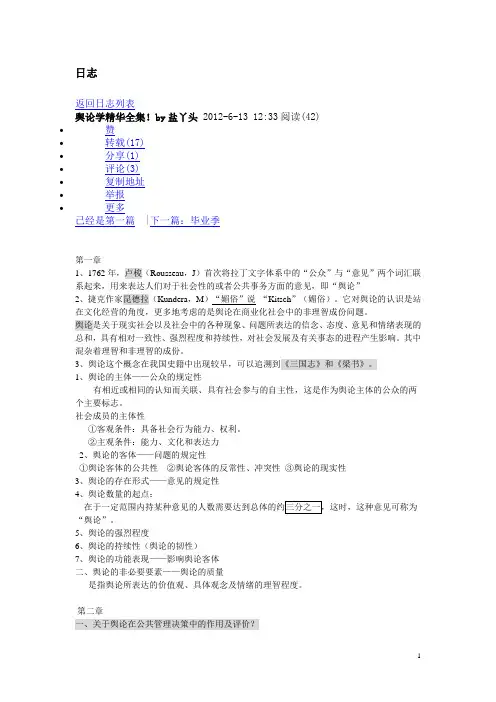
日志返回日志列表舆论学精华全集!by盐丫头2012-6-13 12:33阅读(42)•赞•转载(17)•分享(1)•评论(3)•复制地址•举报•更多已经是第一篇|下一篇:毕业季第一章1、1762年,卢梭(Rousseau,J)首次将拉丁文字体系中的“公众”与“意见”两个词汇联系起来,用来表达人们对于社会性的或者公共事务方面的意见,即“舆论”2、捷克作家昆德拉(Kundera,M)“媚俗”说“Kitsch”(媚俗)。
它对舆论的认识是站在文化经营的角度,更多地考虑的是舆论在商业化社会中的非理智成份问题。
舆论是关于现实社会以及社会中的各种现象、问题所表达的信念、态度、意见和情绪表现的总和,具有相对一致性、强烈程度和持续性,对社会发展及有关事态的进程产生影响。
其中混杂着理智和非理智的成份。
3、舆论这个概念在我国史籍中出现较早,可以追溯到《三国志》和《梁书》。
1、舆论的主体——公众的规定性有相近或相同的认知而关联、具有社会参与的自主性,这是作为舆论主体的公众的两个主要标志。
社会成员的主体性①客观条件:具备社会行为能力、权利。
②主观条件:能力、文化和表达力2、舆论的客体——问题的规定性①舆论客体的公共性②舆论客体的反常性、冲突性③舆论的现实性3、舆论的存在形式——意见的规定性4、舆论数量的起点:在于一定范围内持某种意见的人数需要达到总体的约三分之一,这时,这种意见可称为“舆论”。
5、舆论的强烈程度6、舆论的持续性(舆论的韧性)7、舆论的功能表现——影响舆论客体二、舆论的非必要要素——舆论的质量是指舆论所表达的价值观、具体观念及情绪的理智程度。
第二章一、关于舆论在公共管理决策中的作用及评价?1代表人物:柏拉图/黑格尔/李普曼核心思想:舆论是一个意见的大杂烩,公众不能理解政府运作,其发表的意见是可疑的,价值是有限的。
代表人物:马基雅弗利/洛克/卢梭/边沁/杰弗逊/马克思核心思想:从政治民主、尊重人权的角度,给予舆论比较多的肯定。
2005年第6期N o .6.2005杭州师范学院学报(社会科学版)Jour nal of Hangzhou Teache rs Co ll e ge(Soc i a lSc i e nces Ed i t ion)2005年11月N ov .2005收稿日期:2005-09-28作者简介:赵孟营(1966-),男,江西九江人,社会学博士,北京师范大学哲学与社会学学院副院长,副教授,社会学系系主任。
沟通理论的嵌入:哈贝马斯如何修正社会进化理论赵孟营(北京师范大学哲学与社会学学院,北京100875)摘要:哈贝马斯以沟通理论作为修正社会进化论的工具,建构了沟通理论的社会进化论,该理论的关注点在于社会的理性结构和规范结构的发展。
关键词:哈贝马斯;沟通理论;社会进化中图分类号:B03 文献标识码:A 文章编号:1000-2146(2005)06-0005-05社会理论家们对哈贝马斯的沟通理论本身的关注已卓有成效,而对其以沟通理论为基础的社会发展观的研究尚差强人意。
[1]事实上,哈贝马斯将其社会发展理论的旨趣界定位/重建历史唯物主义0。
在笔者看来,其社会发展观应当命名为/沟通理论的社会进化论0,而要义乃是修正的社会进化理论,他所倚重的修正路径则是沟通理论的嵌入,他所关注的焦点是人类社会/理性结构0的进化特征和/规范结构0的进化特征。
本文试图以5重建历史唯物主义#导论6为基础,对哈氏的/沟通理论的社会进化论0的理论轮廓加以梳理,以供方家批评指正。
一 理论建构的立场、方向与方法论基础(一)建构沟通理论的社会进化论的基本立场这一立场是/重建历史唯物主义0而不是/复兴0或/复辟0历史唯物主义。
哈贝马斯指出:/我们所说的重建是把一种理论拆开,用新的形式重新加以组合,以使更好地达到这种理论所确立的目标。
0[2](P4)这表明了他的基本看法:作为社会发展理论的历史唯物主义需要发展,但是历史唯物主义的潜在力量并未枯竭。
哈贝马斯是把唯物主义当作一种特别的社会进化理论来看待的。
复杂网络上的舆情演化模型研究现状与展望钱亚飞【期刊名称】《《现代计算机(专业版)》》【年(卷),期】2019(000)022【总页数】4页(P43-46)【关键词】社会网络; 舆情演化; 复杂网络【作者】钱亚飞【作者单位】西华大学计算机与软件工程学院成都 610039【正文语种】中文0 引言近年来,在飞速发展的互联网的带动下,各种各样的社交平台给广大网民提供了很多的开放式的交换意见的平台。
根据《中国互联网发展状况统计报告》显示,当前中国网民数量已经超过8.3 亿人,当很多谣言或者是舆论在如此巨大的网络流量中传播时,相比传统的社会网络如今的复杂网络系统传播舆情的范围会更加的宽广,对社会的和谐稳定会产生更大的影响。
因此,探索舆情在复杂网络系统中的网民传播舆情演化的规律来为相关监管部门提供理论的一些指导这一研究趋势成为了广大国内外学者的研究方向。
20 世纪末,Watts[1]发现大千世界中的复杂系统都有类似的网络拓扑结构属性,其中最突出的就是一个节点经过几步就可以到达另外一个节点,于是用“六度分离”理论构建了小世界网络模型。
Watts[2-3]在规则网络的基础上建立了WS 小世界模型和NW 小世界模型。
在这之后复杂网络上最重要的发现当数无标度网络的发现,Barabasi 和Albert[4]发现复杂网络系统中都具有“增长”和“优先链接”的特点,而且证明了互联网、电网等网络都具有这个特性,这使得对网络模型的研究从以前的静态模型转到了动态的演化。
但是随着现实复杂系统的发展,无标度网络已经不足以描述现实的网络,于是Yook S H[5]在无标度网络的基础上衍生出了加权无标度网络,它可以很好地描述各连接边之间的异质性。
随着Web2.0 时代的到来,各类的舆情传播变得更加的复杂多变,伴随着复杂网络理论的飞速发展,很大程度使得舆论方面的研究得到很好的发展。
从最早的个体行为传播到集体活动的演化,很多的经典动力学模型都和复杂网络模型结合起来,产生了很多经典的舆情传播模型。
哈贝马斯与公共领域的发掘及其效应作者:董浩来源:《阅江学刊》2019年第06期摘要:《公共领域的结构转型》是德国著名哲学家哈贝马斯的代表作,十分值得阅读与研究。
但由于其思想的丰富、多元,文字的艰深与晦涩,导致理解其思想存在一定难度。
笔者尝试借助知识社会学的理论与方法,通过考察哈贝马斯写作该书的历史语境、学术脉络来理解哈氏对公共领域的发掘及其引发的学术与社会效应。
不仅包括因他与他的法兰克福导师们之间存在复杂的学术政治关系而导致该书命运多舛、社会各界对他的忽视,更包括时代与社会对他的再审视。
哈贝马斯与其著作《公共领域的结构转型》“一波三折”的学术故事,勾勒出一个相对全面、清晰、系统的关于公共领域的知识地图。
哈氏的公共领域思想不仅承继了阿伦特关于公共领域思想的学术谱系,还来源于哈氏个人的生活经历:虽然哈氏的公共领域思想经历了一系列的波折与沉浮,但随着时代与社会的发展,最终这一思想不仅被重新发掘,得到学界的普遍重视,而且在具体的研究、运用中,又获得了一些新的发展与扩充。
关键词:哈贝马斯;汉娜·阿伦特;公共领域;第三领域;知识社会学;交往行为理论中图分类号:G206.3 文献标识码:A 文章分类号:1674-7089(2019)06-00089-08作者简介:董浩,南京师范大学新闻与传播学院博士研究生。
一、引言2019年对世界上关注和研究哈贝马斯(Jurgen Habermas)的学者来说,是非常重要又特殊的一年。
对于中国研究哈贝马斯的学者来说,亦是如此。
一是因为2019年是哈贝马斯诞辰90周年。
按照惯例,哈贝马斯的弟子们及研究者们,将会像以往每逢哈贝马斯诞辰整年那样,举办纪念兼讨论哈贝马斯及其思想的研讨会,并会结集出版相关纪念、总结性文章。
二是哈贝马斯是当今世界上为数不多仍在世的、能够享誉全球并对全球学术界产生过重要影响的哲学家、社会学家。
三是由于哈贝马斯年事已高。
今年他极有可能会对自己的学术生涯、学术思想作一个总结。
2023年自考专业(公共关系)《传播学概论》考试全真模拟易错、难点汇编贰(答案参考)(图片大小可自由调整)一.全考点综合测验(共50题)1.【单选题】霍夫兰等人关于“说服与态度改变”的实证研究始于()A.第一次世界大战期间B.二十世纪二十年代C.第二次世界大战期间D.二十世纪六十年代正确答案:C2.【单选题】麦克卢汉媒介理论的中心论点是()。
A.“地球村”B.“媒介有冷热之分”C.“媒介即信息”D.“媒介是人体的延伸”正确答案:C3.【单选题】赫尔塔·赫佐格发现,许多妇女收听连续广播剧的动机是()。
A.获得信息B.满足心理需要C.相互交往D.获取文化知识正确答案:B4.【单选题】从信息流量的角度看,人们对某个电视广告之所以产生了逆反心理,原因在于该广告()A.播出次数太多B.画面切换太快C.播出次数太少D.画面切换太慢正确答案:A5.【单选题】赫尔塔·赫佐格发现,许多妇女收听连续广播剧的动机是()A.获得信息B.满足心理需要C.相互交往D.获取文化知识正确答案:B6.【单选题】斯蒂芬森关于传播功能的观点,主要涉及()A.人际传播B.群体传播C.组织传播D.大众传播正确答案:A7.【问答题】受众的主要特征是什么?正确答案:(1)广泛性。
受众必然是众多的,受众成员是广泛分布在各个地区。
(3)分散性。
大众传播在时间上和空间上都是分隔开的,无法展开当场的对话交流。
(4)隐匿性。
传播者一般并不认识各受众成员,并不知道他们的具体情况,无法确定各受众成员的个人情况。
8.【单选题】拉斯韦尔模式的不足之一是孤立性,即没有涉及传播过程与一个因素的联系。
这个因素是()A.控制过程B.社会过程C.编码过程D.反馈过程正确答案:B9.【单选题】奥斯古德—施拉姆模式由两个大圆和两个小圆以及联结它们的线条组成。
其中左边那个大圆中的文字,依次为()A.编码—解释者—译码B.编码—讯息—译码C.译码—解释者—编码正确答案:A10.【单选题】“沉默的螺旋”的一个重要理论前提是个人对社会孤立的()。